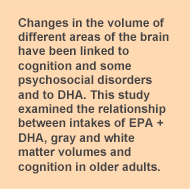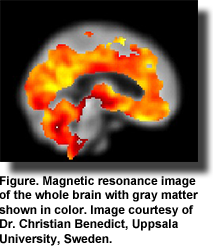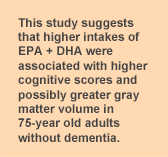
DHA, one of the main long-chain omega-3 fatty acids in seafoods, is found in large quantities in brain where it affects the structure and function of neurons and the growth of new ones. It has been linked to cognitive function, attention, visual acuity, behavior and some psychiatric disorders. It also helps protect neurons from the damaging effects of Alzheimer’s disease. It is difficult to study the brain and neurons directly in living individuals, so that substitute methods must be used. One of the most useful of these is magnetic resonance imaging, which distinguishes between gray and white matter volumes and reveals patterns of cortical activation (Figure). The technique is being used more frequently to study how different parts of the brain change in response to certain conditions and in some diseases. For example, smaller volume in the hippocampus is associated with worse clinical outcomes in patients with major depressive disorder.

Changes in brain volumes have been used to study cognitive function. It was reported that individuals who had greater volumes in the medial temporal area maintained their cognitive status better than those whose cognition declined. Researchers have also used changes in the volumes of the whole brain and of specific regions to predict the conversion from mild cognitive impairment to Alzheimer’s disease. In this report, investigators examined the relationships between omega-3 fatty acid consumption (particularly of EPA and DHA), brain volumes and cognitive status in adults at 70 years of age and 5 years later.

The investigators assessed the participants’ EPA + DHA intakes, measured the total volumes of gray and white matter using magnetic resonance imaging and evaluated cognitive performance after 5 years. When the observations were analyzed according to 4 categories of omega-3 consumption, those with the highest intakes had the highest cognition scores and greatest gray matter volumes compared with those in the lowest omega-3 intake group. However, when the analysis was adjusted for additional confounding variables the relationship between EPA + DHA intakes and gray matter volume was no longer significant. EPA + DHA intakes remained significantly related to higher cognitive scores. The study demonstrated a clear relationship between higher cognitive scores and higher intakes of EPA + DHA and suggested, but fell short of confirming, that gray matter volumes were also greater among those with the highest omega-3 intakes. The study did not report changes in gray and white matter volumes in different regions of the brain, so that possibly certain brain regions might be more sensitive to seafood omega-3 intakes than others. It should also be noted that those with the highest intakes of EPA + DHA consumed an average of 980 mg per day, nearly 10 times the current intakes of US adults.
 DHA, one of the main long-chain omega-3 fatty acids in seafoods, is found in large quantities in brain where it affects the structure and function of neurons and the growth of new ones. It has been linked to cognitive function, attention, visual acuity, behavior and some psychiatric disorders. It also helps protect neurons from the damaging effects of Alzheimer’s disease. It is difficult to study the brain and neurons directly in living individuals, so that substitute methods must be used. One of the most useful of these is magnetic resonance imaging, which distinguishes between gray and white matter volumes and reveals patterns of cortical activation (Figure). The technique is being used more frequently to study how different parts of the brain change in response to certain conditions and in some diseases. For example, smaller volume in the hippocampus is associated with worse clinical outcomes in patients with major depressive disorder.
DHA, one of the main long-chain omega-3 fatty acids in seafoods, is found in large quantities in brain where it affects the structure and function of neurons and the growth of new ones. It has been linked to cognitive function, attention, visual acuity, behavior and some psychiatric disorders. It also helps protect neurons from the damaging effects of Alzheimer’s disease. It is difficult to study the brain and neurons directly in living individuals, so that substitute methods must be used. One of the most useful of these is magnetic resonance imaging, which distinguishes between gray and white matter volumes and reveals patterns of cortical activation (Figure). The technique is being used more frequently to study how different parts of the brain change in response to certain conditions and in some diseases. For example, smaller volume in the hippocampus is associated with worse clinical outcomes in patients with major depressive disorder.  Changes in brain volumes have been used to study cognitive function. It was reported that individuals who had greater volumes in the medial temporal area maintained their cognitive status better than those whose cognition declined. Researchers have also used changes in the volumes of the whole brain and of specific regions to predict the conversion from mild cognitive impairment to Alzheimer’s disease. In this report, investigators examined the relationships between omega-3 fatty acid consumption (particularly of EPA and DHA), brain volumes and cognitive status in adults at 70 years of age and 5 years later.
Changes in brain volumes have been used to study cognitive function. It was reported that individuals who had greater volumes in the medial temporal area maintained their cognitive status better than those whose cognition declined. Researchers have also used changes in the volumes of the whole brain and of specific regions to predict the conversion from mild cognitive impairment to Alzheimer’s disease. In this report, investigators examined the relationships between omega-3 fatty acid consumption (particularly of EPA and DHA), brain volumes and cognitive status in adults at 70 years of age and 5 years later.  The investigators assessed the participants’ EPA + DHA intakes, measured the total volumes of gray and white matter using magnetic resonance imaging and evaluated cognitive performance after 5 years. When the observations were analyzed according to 4 categories of omega-3 consumption, those with the highest intakes had the highest cognition scores and greatest gray matter volumes compared with those in the lowest omega-3 intake group. However, when the analysis was adjusted for additional confounding variables the relationship between EPA + DHA intakes and gray matter volume was no longer significant. EPA + DHA intakes remained significantly related to higher cognitive scores. The study demonstrated a clear relationship between higher cognitive scores and higher intakes of EPA + DHA and suggested, but fell short of confirming, that gray matter volumes were also greater among those with the highest omega-3 intakes. The study did not report changes in gray and white matter volumes in different regions of the brain, so that possibly certain brain regions might be more sensitive to seafood omega-3 intakes than others. It should also be noted that those with the highest intakes of EPA + DHA consumed an average of 980 mg per day, nearly 10 times the current intakes of US adults.
The investigators assessed the participants’ EPA + DHA intakes, measured the total volumes of gray and white matter using magnetic resonance imaging and evaluated cognitive performance after 5 years. When the observations were analyzed according to 4 categories of omega-3 consumption, those with the highest intakes had the highest cognition scores and greatest gray matter volumes compared with those in the lowest omega-3 intake group. However, when the analysis was adjusted for additional confounding variables the relationship between EPA + DHA intakes and gray matter volume was no longer significant. EPA + DHA intakes remained significantly related to higher cognitive scores. The study demonstrated a clear relationship between higher cognitive scores and higher intakes of EPA + DHA and suggested, but fell short of confirming, that gray matter volumes were also greater among those with the highest omega-3 intakes. The study did not report changes in gray and white matter volumes in different regions of the brain, so that possibly certain brain regions might be more sensitive to seafood omega-3 intakes than others. It should also be noted that those with the highest intakes of EPA + DHA consumed an average of 980 mg per day, nearly 10 times the current intakes of US adults.

